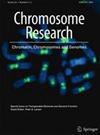Comparative cytogenomics reveals genome reshuffling and centromere repositioning in the legume tribe Phaseoleae
IF 2.8
4区 生物学
Q3 BIOCHEMISTRY & MOLECULAR BIOLOGY
引用次数: 2
Abstract
The tribe Phaseoleae includes several legume crops with assembled genomes. Comparative genomic studies have evidenced the preservation of large genomic blocks among legumes, although chromosome dynamics during Phaseoleae evolution has not been investigated. We conducted a comparative genomic analysis to define an informative genomic block (GB) system and to reconstruct the ancestral Phaseoleae karyotype (APK). We identified GBs based on the orthologous genes between Phaseolus vulgaris and Vigna unguiculata and searched for GBs in different genomes of the Phaseolinae ( P. lunatus ) and Glycininae ( Amphicarpaea edgeworthii ) subtribes and Spatholobus suberectus (sister to Phaseolinae and Glycininae), using Medicago truncatula as the outgroup. We also used oligo-FISH probes of two P. vulgaris chromosomes to paint the orthologous chromosomes of two non-sequenced Phaseolinae species. We inferred the APK as having n = 11 and 19 GBs (A to S), hypothesizing five chromosome fusions that reduced the ancestral legume karyotype to n = 11. We identified the rearrangements among the APK and the subtribes and species, with extensive centromere repositioning in Phaseolus . We also reconstructed the chromosome number reduction in S. suberectus . The development of the GB system and the proposed APK provide useful approaches for future comparative genomic analyses of legume species.比较细胞基因组学揭示豆科菜豆基因组改组和着丝粒重新定位
Phaseoleae部落包括几种具有组装基因组的豆类作物。尽管尚未对菜豆进化过程中的染色体动力学进行研究,但比较基因组研究已经证明在豆类中保留了大的基因组块。我们进行了一项比较基因组分析,以确定一个信息基因组块(GB)系统,并重建祖先的菜豆核型(APK)。我们根据普通菜豆和有蹄目Vigna unguiculata之间的直向同源基因鉴定了GBs,并以截茎苜蓿为外群,在菜豆科(P.lunatus)和大豆科(Amphicarpaea edgeworthii)亚系和近直血藤(菜豆科和大豆科的姐妹)的不同基因组中寻找GBs。我们还使用两条P.vulgaris染色体的寡聚FISH探针绘制了两个未测序的Phaseolinae物种的同源染色体。我们推断APK具有n = 11和19 GBs(A到S),假设五个染色体融合将祖先的豆类核型减少到n = 11.我们确定了APK与亚种和物种之间的重排,在菜豆中有大量的着丝粒重新定位。我们还重建了近直肌梭染色体数目的减少。GB系统的开发和提出的APK为未来豆类物种的比较基因组分析提供了有用的方法。
本文章由计算机程序翻译,如有差异,请以英文原文为准。
求助全文
约1分钟内获得全文
求助全文
来源期刊

Chromosome Research
生物-生化与分子生物学
CiteScore
4.70
自引率
3.80%
发文量
31
审稿时长
1 months
期刊介绍:
Chromosome Research publishes manuscripts from work based on all organisms and encourages submissions in the following areas including, but not limited, to:
· Chromosomes and their linkage to diseases;
· Chromosome organization within the nucleus;
· Chromatin biology (transcription, non-coding RNA, etc);
· Chromosome structure, function and mechanics;
· Chromosome and DNA repair;
· Epigenetic chromosomal functions (centromeres, telomeres, replication, imprinting,
dosage compensation, sex determination, chromosome remodeling);
· Architectural/epigenomic organization of the genome;
· Functional annotation of the genome;
· Functional and comparative genomics in plants and animals;
· Karyology studies that help resolve difficult taxonomic problems or that provide
clues to fundamental mechanisms of genome and karyotype evolution in plants and animals;
· Mitosis and Meiosis;
· Cancer cytogenomics.
 求助内容:
求助内容: 应助结果提醒方式:
应助结果提醒方式:


